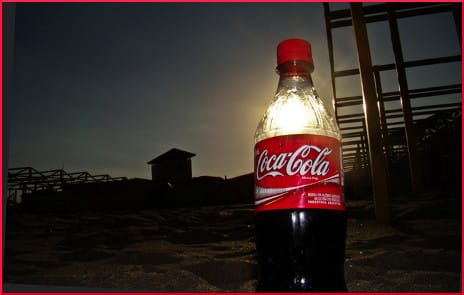Last week was pretty much Coca-Cola week at Childhood Obesity News, culminating in a partial list of our previous posts on the topic. Still, interesting events remain to be mentioned. In the autumn of 2014, Claire Suddath and Duane Stanford wrote for Business Week about how the sugar-sweetened beverage industry’s situation had soured since 1998, when the Center for Science in the Public Interest published its report titled “Liquid Candy.”
Coke identified “obesity and other health concerns” as the biggest shadow hanging over the company’s future success. The corporate bosses decided that the solution was to step up their advertising game. Soft-drink consumption had been dropping since 2005 and the public was in need of re-persuasion. The average American drinks around 450 cans of soda per year, but that wasn’t enough for them. Given that some people eschew soda, for each one of them, somebody out there is drinking 900 cans per year to maintain the 450-unit average.
To make matters worse, the documentary Fed Up devoted much screen time to exposing the devastating effects of SSBs (Sugar Sweetened Beverages), and did not hesitate to name names. There was bad publicity about lawsuits concerning deceptive marketing practices. The writers explained:
For its relaunch to succeed, Coca-Cola first has to reposition itself so that people stop feeling guilty when they drink it… A former Coca-Cola employee, who declined to be identified because he didn’t want to anger his old employer, says the company has a hard time getting restaurant and convenience store chains to reduce their sizes because they make so much money off them.
In November, Coca-Cola announced a truly audacious maneuver: the introduction of a souped-up milk product that would contain more calcium and protein than traditional milk, but half the sugar. Called Fairlife, it would be lactose-free and cost about twice as much as old-fashioned milk. The company had an ad campaign locked and loaded, featuring pin-up girls (including a Person of Color) with a retro look, in revealing dresses made of— wait for it—milk.
While some consumers may welcome this innovation, Snack Girl does not, and says so in a vociferous blog post titled “Fairlife Milk Is So Deceitful That I Can’t Stand It.” What really ticks her off is how the packaging says “from grass to glass,” implying that the cows are grass-fed, which would be a good thing if it were true. Alas, it is not, as Snack Girl learned by calling the manufacturer’s 1-800 number to inquire about the bovine diet.
The cows are fed corn, soy, alfalfa, and a mixture of grains. I asked, “any grass?” The representative said, “No grass”. Then, I said, “Why did you say “from grass to glass” on your package if you aren’t feeding the cows grass?” He said that they use it as a phrase to explain the traceability of the milk to the individual farms…OH! I get it. The farms have grass—but they don’t feed it to their cows.
Around the same time, Huffington Post published a freakish medical memoir called “I Drank So Much Soda as a Child That My Veins Collapsed.” Young Andy Campbell shunned water and was fully addicted to Mountain Dew, which comes from Pepsi, not Coke. But as the old saying goes, “All cats are gray at night,” and all sodas contain basically the same stuff. The ironic twist is that he got turned on to his drug of choice at summer sports camp, “where health is touted in the damn pamphlet.” This example of journalistic candor is so appalling, we can only suggest visiting the site to savor and fully appreciate its gruesomeness.
Your responses and feedback are welcome!
Source: “Coke Confronts Its Big Fat Problem.”BusinessWeek.com, 07/31/14
Source: “Dairy you to try it! Coca-Cola plans to unveil new kind of MILK to boost
profits.” DailyMail.co.uk, 11/25/14
Source: “Fairlife Milk Is So Deceitful That I Can’t Stand It,” snack-girl.com, 04/22/15.
Source: “I Drank So Much Soda as a Child That My Veins Collapsed,” HuffingtonPost.com, 03/27/15
Image by Geronimo De Francesco


 FAQs and Media Requests:
FAQs and Media Requests: 











